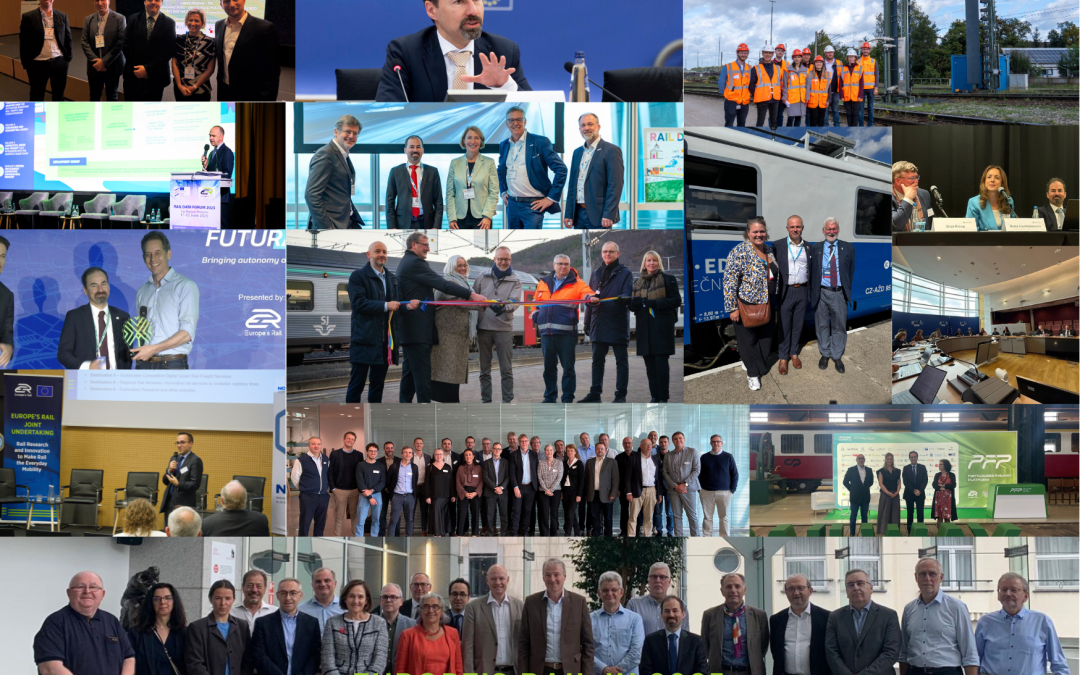2025 saw Europe’s Rail (EU-Rail) make significant progress across multiple initiatives, fostering partnerships and...

This document provides the realized FP4 – Rail4EARTH dissemination & and exploitation actions on the global scope of the project (rolling stock, infrastructure, stations, all related sub-systems and the 28 WPs of the project) during the 2 first two years of the project.
The dissemination of FP4 – Rail4EARTH is essential throughout the project’s life and has been carried out with the cooperation of all Work Packages and many partners of the project. The topics of technical and scientific communications are mainly proposed by the 26 technical WPs (WP1 to WP26). They depend on their respective progress and their results generated during the project realization.
Main achievements during these two years:
• Creation of a project identity;
• Population of the EU-Rail FP4-Rail4EARTH website;
• Physical and online participation to conferences;
• The submission of abstracts for conferences in 2025 ;
• The publication of news through social media;
• The publications of articles in specialized journals;
• The participation to products-oriented exhibition “InnoTrans 2024” (Berlin).
The WP24 allowed a state of the art of the technological status but also about the ambitions of the partners to develop sustainable interiors. The previous deliverables have defined the targets and the first technical ways.
The current deliverable D24.2 is not the progress report of the partners but is focused on the roadmap for the next 2 years (end of Rail4EARTH).
The main results expected by the tasks of WP25 will be presented:
o Priority topics
o Expectation by topic
This document is split in several main parts:
Chapters 4 to 8 present the deliverable compared to the MAWP
Chapter 9 defines the roadmap 2025-2026
Chapter 10 is the conclusion
The aim of this report is to give insight into the topics and tasks of work package 20. The content and time schedule of the two tasks is defined and information about the distribution of work between the partners as well as the methods which will be used are given.
The WP is divided into two tasks, whose motivation and aims are explained. First results and the relevant methodologies are clarified.
Within the task 20.1, the work intends to expand the current state of the art and work towards new regulation requirements that could enable virtual certification in the foreseeable future. The aerodynamic topics, on which the studies will be based on, were defined and a generic train model was designed, which allows the study of the different methods and the validation of numerical results with experimental tests. However, no full-scale data of the generic train will be available. A comparison between numerical results gained with the developed method and full-scale data of a regional train will be delivered by a partner of the WP for validation purposes in the later progress of the WP.
The task 20.2 is dedicated to the optimisation of the train’s roof equipment with regards to noise and mainly drag and therefore fuel consumption and CO2-emission. The same generic train geometry will be utilised for the study of optimal train roof equipment placement. A generic pantograph was generated to give insight into the flow around different parts of the pantograph as well as the forces on the pantograph. The power transfer efficiency is to be optimised by adapting the pantograph aerodynamics.
All tasks are according to the plan, no delays have to be reported.
The D1.1 “Energy Management & Pre-Standardisation for Alternative drive trains and related railway system intermediate report n°1” reports the status of the SP3-WP1 of Rail4EARTH after 16 months of work on the different subtasks:
As this Report is the first intermediate WP1 progress report, some chapters are not fully completed because the work will be continued until end 2026.
The present document constitutes the Deliverable D24.1 “ Sustainable Interiors, knowledge and opportunities intermediate report n°1 ” in the Subproject 6 Attractiveness, Work Package 24 Sustainable Interiors, Knowledge and Opportunities, as described in the EU-RAIL MAWP and contributes as well to the Flagship Project 4 – Rail4Earth.
Dissemination and exploitation plan